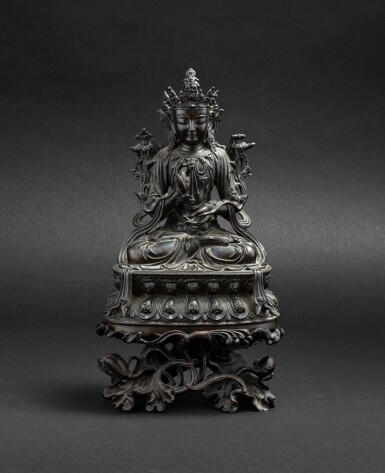
Collection Particulière Française | 法國私人收藏
Belle et grande figure de Bodhisattva en bronze Dynastie Ming, XVE siècle | 明十五世紀 銅菩蕯坐像 | A finely cast large bronze figure of Bodhisattva, Ming Dynasty, 15th century
Auction Closed
December 11, 04:16 PM GMT
Estimate
30,000 - 40,000 EUR
Lot Details
Description
Collection Particulière Française
法國私人收藏
Belle et grande figure de Bodhisattva en bronze Dynastie Ming, XVE siècle
明十五世紀 銅菩蕯坐像
A finely cast large bronze figure of Bodhisattva, Ming Dynasty, 15th century
assise en vajraparyankasana sur un double socle lotiforme, les mains en varada et vitarka mudra tenant des tiges de fleurs de lotus s'épanouissant près des épaules et soutenant des attributs, tête de ruyi et rouleau, symbolisant le triratna et le prajnaparamita, vêtue d'un fin dhoti et richement parée de bijoux, le visage serein surmonté d'une couronne fleuronnée encadrant un chignon orné d'un joyau, scellées, socle en bois en forme de feuille de lotus
(2)
29,5 cm, 11⅝ in.
29.5 公分,11⅝英寸
The bodhisattva is seated in the meditation posture (vajraparyankasana) adorned with regal jewellery, and a billowing scarf draped over the shoulders and falling from the lower arms to the lotus pedestal below. The right hand, held in the teaching gesture (vitarka mudra), holds the stem of a lotus at the right shoulder with a ruyi head symbolising the Buddhist wish-fulfilling jewel (triratna): the flower at the left shoulder supports a scroll representing the Perfection of Wisdom sutra (prajnaparamita), suggesting the iconography of Manjushri, the Lord of Wisdom. The crown type, the beaded chain jewellery, the billowing scarf and the loosely draped robes are done in a stylistic continuum of early Ming sculptural traditions established in the Yongle (1403-1424) and Xuande period (1426-1435).
Unlike the early Ming examples the statue is not gilded: cf. a Chinese non-gilt copper alloy Avalokiteshvara with a Chenghua (1465-1487) reign mark at Poly International Auctions, Beijing, December 1, 2007, lot 979, see Michael Henss, Buddhist Art in Tibet, Ulm, 2008, p. 224, fig. 56: and a Chinese non-gilt copper alloy Tara from the second half of the 15th century sold in Sotheby’s Paris, 11 June 2019, lot 24. Close stylistic comparisons with the Chenghua Avalokiteshvara and the Sotheby’s Tara suggest that this example dates to the second half of the 15th century.
